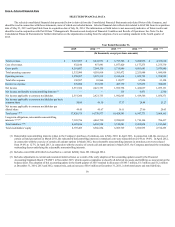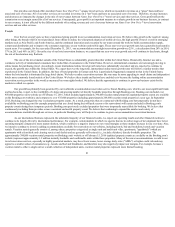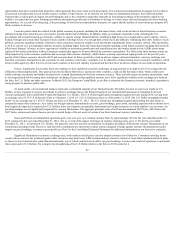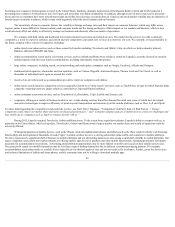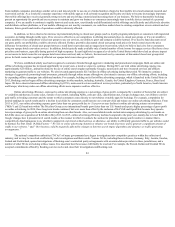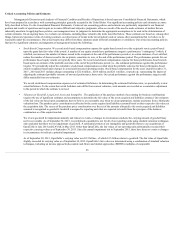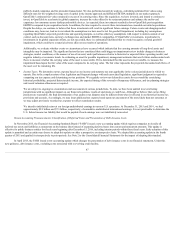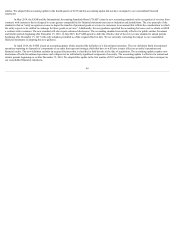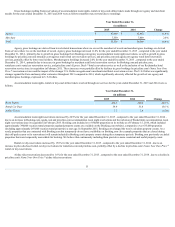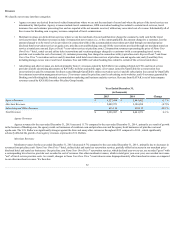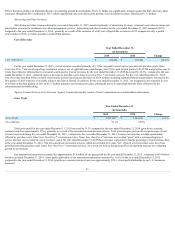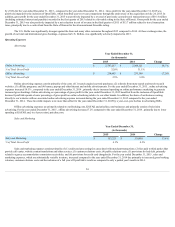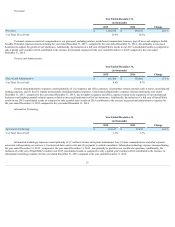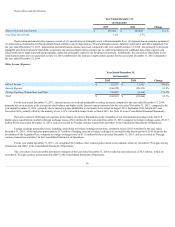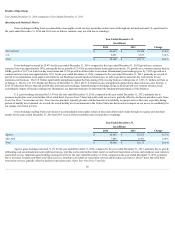Priceline 2015 Annual Report Download - page 51
Download and view the complete annual report
Please find page 51 of the 2015 Priceline annual report below. You can navigate through the pages in the report by either clicking on the pages listed below, or by using the keyword search tool below to find specific information within the annual report.
will be presented in our balance sheets as a direct deduction from the related debt liability rather than as an asset. This accounting change is consistent with the
current presentation under U.S. GAAP for debt discounts and it also converges the guidance under U.S. GAAP with that in the International Financial Reporting
Standards ("IFRS"). Debt issuance costs will reduce the proceeds from debt borrowings in our cash flow statement instead of being presented as a separate line in
the financing section of that statement. Amortization of debt issuance costs will continue to be reported as interest expense in our income statement. This
accounting update does not affect the current accounting guidance for the recognition and measurement of debt issuance costs. This update is effective for public
business entities for fiscal years, and interim periods within those fiscal years, beginning after December 15, 2015. Early adoption is allowed for all entities for
financial statements that have not been previously issued. We adopted this accounting update in the fourth quarter of 2015 and applied it retrospectively to prior
periods. See Note 2 to our Consolidated Financial Statements for the impact of adopting this standard.
Other Recent Accounting Pronouncements
In January 2016, the FASB issued a new accounting update which amends the guidance on the classification and measurement of financial instruments.
Although the accounting update retains many current requirements, it significantly revises accounting related to (1) the classification and measurement of
investments in equity securities and (2) the presentation of certain fair value changes for financial liabilities measured at fair value. The accounting update also
amends certain fair value disclosures of financial instruments and clarifies that an entity should evaluate the need for a valuation allowance on a deferred tax asset
related to available-for-sale debt securities in combination with the entity’s evaluation of their other deferred tax assets. The update requires entities to carry all
investments in equity securities, including other ownership interests such as partnerships, unincorporated joint ventures and limited liability companies at fair
value, with fair value changes recognized through net income. This requirement does not apply to investments that qualify for equity method accounting,
investments that result in consolidation of the investee or investments in which the entity has elected the practicability exception to fair value measurement. Under
current U.S. GAAP, our available-for-sale investments in equity securities with readily identifiable market value are remeasured to fair value each reporting period
with changes in fair value recognized in accumulated other comprehensive income (loss). However, under the new accounting literature, fair value adjustments will
be recognized through net income and could vary significantly quarter to quarter. For the investments currently accounted for under the cost method, an entity can
elect to measure its investments, which do not have a readily determinable fair value, at cost less impairment, if any, plus or minus changes resulting from
observable price changes in orderly transactions for the identical or a similar investment of the same issuer. Additionally, this accounting update will simplify the
impairment assessment of equity investments without readily determinable fair values by requiring a qualitative assessment to identify impairment. When a
qualitative assessment indicates that impairment exists, an entity is required to measure the investment at fair value. In addition, this accounting update eliminates
the requirement for public business entities to disclose the methods and significant assumptions used to estimate the fair value that is currently required to be
disclosed for financial instruments measured at amortized cost in the balance sheet. This update is effective for fiscal years beginning after December 15, 2017,
including interim periods within those fiscal years. Early adoption, although allowed in certain circumstances, is not applicable to us.
In September 2015, the FASB issued a new accounting update which simplifies the accounting for measurement-period adjustments to provisional
amounts recognized in a business combination. Under this new guidance, an acquirer must recognize these adjustments in the reporting period in which the
adjustment amounts are determined. The new accounting guidance also requires an acquirer to present separately on the face of the income statement, or disclose in
the notes, the amount recorded in current-period earnings by line item that would have been recorded in previous reporting periods if the adjustment to provision
amounts had been recognized as of the acquisition date. This update is effective for fiscal years beginning after December 15, 2015, including interim periods
within those fiscal years. Early adoption is permitted for financial statements that have not been issued. We adopted this new accounting standard in the fourth
quarter of 2015 and this accounting standard did not have an impact to our consolidated financial statements.
In April 2015, the FASB issued a new accounting update which requires an entity that enters into a cloud computing arrangement to determine if the
arrangement contains a software license. The accounting update cites software as a service, platform as a service, infrastructure as a service and other similar
hosting arrangements as examples of cloud computing arrangements. A software license arrangement exists if both of the following criteria are met: (1) the
customer has a contractual right to take possession of the underlying software without significant penalty and (2) it is feasible for the customer to run the software
on their own hardware or to contract with another party unrelated to the vendor to run the software. If the arrangement meets both of these criteria, the customer
would need to identify what portion of the cost relates to purchasing the software and what portion relates to paying for the service of hosting the software. The
purchased software would be accounted for using the internal-use software guidance and the service costs would be accounted for as an operating expense. If the
arrangement does not meet both of the criteria, the cost is an operating expense for a service contract. The guidance in this update does not change the accounting
for a service contract. The update is effective for public business entities for fiscal years, and interim periods within those fiscal years, beginning after December
15, 2015. Early adoption is allowed for all
48


